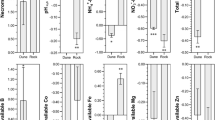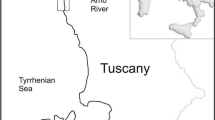Abstract
Coastal dune areas are valuable ecosystems, generally impacted by habitat destruction and invasive alien species. In this study, we assessed how human disturbance and invasion by Carpobrotus edulis impact the soils and the establishment of native flora in the north-western coastal regions of Spain. We compared soil characteristics (pH, conductivity, water content, nutrients and enzymatic activities) and native plant as well as C. edulis fitness correlates (germination and early growth) between uninvaded and invaded soils from urban and natural coastal dune areas. We found that human disturbance impacts coastal soils by increasing organic matter and water content, modifying soil nutrients and cycles, and reducing the pH in urban soils. The presence of invasive C. edulis further increases these impacts. These changes in soil characteristics allow for the establishment of the native, but ruderal, Scolymus hispanicus and non-native C. edulis, both of which are not adapted to the typically limiting conditions of coastal dunes. In some instances, the coastal dune endemic, Malcolmia littorea, showed no fitness effects in response to urbanization or the presence of C. edulis. These results suggest that human disturbed coastal areas might be more easily invaded than natural areas. More broadly, our findings of differential responses of different native species to disturbance and invasion, illustrate the need for multi-taxon approaches when assessing the impacts of invasive species.


Similar content being viewed by others
References
Akasaka M, Osawa T, Ikegami M (2015) The role of roads and urban area in occurrence of an ornamental invasive weed: a case of Rudbeckia laciniata L. Urban Ecosyst. doi:10.1007/s11252-015-0466-4
Albert ME (1995) Portrait of an invader II: the ecology and management of Carpobrotus edulis. CalEPPC News Spring 95:4–6
Allen SE (1989) Chemical analysis of ecological materials. Blackwell Scientific Publications, Hoboken
Allison SD, Vitousek PM (2004) Extracellular enzyme activities and carbon chemistry as drivers of tropical plant litter decomposition. Biotropica 36:285–296. doi:10.1111/j.1744-7429.2004.tb00321.x
Ariza E, Jimenez JA, Sarda R, Villares M, Pinto J, Fraguell R et al (2010) Proposal for an integral quality index for urban and urbanized beaches. Environ Manage 45(5):998–1013
Badalamenti E, Luciano G, Armando LV et al (2016) The impact of Carpobrotus cfr. acinaciformis (L.) L. Bolus on soil nutrients, microbial communities structure and native plant communities in Mediterranean ecosystems. Plant Soil. doi:10.1007/s11104-016-2924-z
Berendse AF, Lammerts EJ, Olff H, Ecology SP (1998) Soil organic matter accumulation and its implications for nitrogen mineralization and plant species composition during succession in coastal dune slacks reviewed work (s): soil organic matter accumulation and its implications for nitrogen and plant spec. Plant Ecol 137:71–78
Bot A, Benites J (2005) The importance of soil organic matter: key to drought-resistant soil and sustained food production (No. 80). Food and Agriculture Organization
Cao C, Jiang S, Ying Z et al (2011) Spatial variability of soil nutrients and microbiological properties after the establishment of leguminous shrub Caragana microphylla lam. plantation on sand dune in the horqin sandy land of northeast china. Ecol Eng 37:1467–1475. doi:10.1016/j.ecoleng.2011.03.012
Carboni M, Carranza ML, Acosta A (2009) Assessing conservation status on coastal dunes: a multiscale approach. Landsc Urban Plan 91:17–25. doi:10.1016/j.landurbplan.2008.11.004
Chiapusio G, Sanchez M, Reigosa MJ et al (1997) Do germination indices adequately reflect allelochemical effects on the germination process? J Chem Ecol 23:2445–2453. doi:10.1023/B:JOEC.0000006658.27633.15
Conser C, Connor EF (2009) Assessing the residual effects of Carpobrotus edulis invasion, implications for restoration. Biol Invasions 11:349–358. doi:10.1007/s10530-008-9252-z
D’Antonio CM (2006) Global invasive species database. National Biological Information Infrastructure and Invasive Species Specialist Group
D’Antonio CM, Haubensak K (1998) Community and ecosystem impacts of introduced species. Fremontia 26:13–18
D’Antonio CM, Mahall B (1991) Root profiles and competition between the invasive, exotic perennial, Carpobrotus edulis, and two native shrub species in California coastal scrub. Am J Bot 78:885–894
D’Antonio CM, Vitousek PM (1992) Biological invasions by exotic grasses, the grass/fire cycle, and global change. Annu Rev Ecol Syst 23:63–87
de la Peña E, de Clercq N, Bonte D et al (2010) Plant-soil feedback as a mechanism of invasion by Carpobrotus edulis. Biol Invasions 12:3637–3648. doi:10.1007/s10530-010-9756-1
Dehnen-Schmutz K, Touza J, Perrings C, Williamson M (2007) A century of the ornamental plant trade and its impact on invasion success. Divers Distrib 13:527–534. doi:10.1111/j.1472-4642.2007.00359.x
Everard M, Jones L, Watts B (2010) Have we neglected the societal importance of sand dunes? An ecosystem services perspective. Aquat Conserv Mar Freshw Ecosyst 20:476–487. doi:10.1002/aqc.1114
Feng MH, Shan XQ, Zhang SZ, Wen B (2005) Comparison of a rhizosphere-based method with other one-step extraction methods for assessing the bioavailability of soil metals to wheat. Chemosphere 59:939–949. doi:10.1016/j.chemosphere.2004.11.056
Foxcroft LC, Richardson DM, Wilson JRU (2008) Ornamental plants as invasive aliens: problems and solutions in Kruger National Park, South Africa. Environ Manag 41:32–51. doi:10.1007/s00267-007-9027-9
Gaertner M, Larson BMH, Irlich UM et al (2016) Managing invasive species in cities: a framework from Cape Town, South Africa? Landsc Urban Plan 151:1–9. doi:10.1016/j.landurbplan.2016.03.010
Gallagher KG, Schierenbeck KA, D’Antonio CM (1997) Hybridization and introgression in Carpobrotus spp. (Aizoaceae) in California, II. Allozyme evidence. Am J Bot 84:905–911
García-Mora MR, Gallego-Fernández JB, Williams AT, García-Novo F (2001) A coastal Dune Vulnerability classification: a case study of the SW Iberian Peninsula. J Coast Res 17:802–811
GEIB (2006) TOP 20: Las 20 especies exóticas invasoras más dañinas presentes en España
German DP, Chacon SS, Allison SD (2011) Substrate concentration and enzyme allocation can affect rates of microbial decomposition. Ecology 92:1471–1480. doi:10.1890/10-2028.1
Grime JP (1997) Ecology: biodiversity and ecosystem function: the Debate Deepens. Science (80-) 277:1260–1261
Grootjans AP, Adema EB, Bekker RM, Lammerts EJ (2004) Why coastal dune slacks sustain a high biodiversity. In: Martínez ML, Psuty NP (eds) Coastal dunes: ecology and conservation (Ecological Studies 171). Springer, Berlin, pp 85–101
Guitián F, Carballas T (1976) Ténicas de análisis de suelos. Pico Sacro, Santiago de compostela
Jiménez JA, Gracia V, Valdemoro HI et al (2011) Managing erosion-induced problems in NW Mediterranean urban beaches. Ocean Coast Manag 54:907–918. doi:10.1016/j.ocecoaman.2011.05.003
Kachi N, Hiros T (1983) Limiting nutrients for plant growth in coastal sand dune soils. J Ecol 71:937–944
Kandeler E, Gerber H (1988) Short-term assay of soil urease activity using colorimetric determination of ammonium. Biol Fertil Soils 6:68–72. doi:10.1007/BF00257924
Klotz S, Kühn I (2010) Urbanisation and alien invasion. In: Gaston KJ (ed) Urban ecology. Cambridge University Press, Cambridge, pp 120–133
Kowarik I (2011) Novel urban ecosystems, biodiversity, and conservation. Environ Pollut 159:1974–1983. doi:10.1016/j.envpol.2011.02.022
Lechuga-Lago Y, Sixto-Ruiz M, Roiloa SR, González L (2016) Clonal integration facilitates the colonization of drought environments by plant invaders. AoB Plant 8:1–11. doi:10.1093/aobpla/plw023
Martínez ML, Maun AM, Psuty NP (2004a) The fragility and conservation of the world’s coastal dunes: geomorphological, ecological, and socioeconomic perspectives. In: Martínez ML, Psuty N (eds) Coastal dunes: ecology and conservation. Springer, Berlin, pp 355–370
Martínez ML, Psuty NP, Lubke RA (2004b) A perspective on coastal dunes. In: Coast dunes, ecology and conservation. Ecolog, vol 171, 3–10. doi: 10.1007/978-3-540-74002-5_1
Maun MA (1994) Adaptations enhancing survival and establishment of seedlings on coastal dune systems. Vegetatio 111:59–70. doi:10.2307/20046398
Maun MA (2009) The biology of coastal sand dunes. Oxford University Press, Oxford
Millenium Ecosystem Assessment (2005) Ecosystems and human well-being. Synthesis. Island Press, Washington
Nobis MP, Jaeger JAG, Zimmermann NE (2009) Neophyte species richness at the landscape scale under urban sprawl and climate warming. Divers Distrib 15:928–936
Novoa A, González L (2014) Impacts of Carpobrotus edulis (L.) N.E.Br. on the germination, establishment and survival of native plants: a clue for assessing its competitive strength. PLoS ONE 9:e107557. doi:10.1371/journal.pone.0107557
Novoa A, González L, Moravcová L, Pyšek P (2012) Effects of soil characteristics, allelopathy and frugivory on establishment of the invasive plant Carpobrotus edulis and a co-occuring native, Malcolmia littorea. PLoS ONE. doi:10.1371/journal.pone.0053166
Novoa A, González L, Moravcová L, Pyšek P (2013a) Constraints to native plant species establishment in coastal dune communities invaded by Carpobrotus edulis: Implications for restoration. Biol Conserv 164:1–9. doi:10.1016/j.biocon.2013.04.008
Novoa A, Rodríguez R, Richardson D, González L (2013b) Soil quality: a key factor in understanding plant invasion? The case of Carpobrotus edulis (L.) N.E.Br. Biol Invasions 16:429–443. doi:10.1007/s10530-013-0531-y
Olff H, Huisman J, Van Tooren B (1993) Species dynamics and nutrient accumulation during early primary succession in coastal sand dunes. J Ecol 81:693–706. doi:10.2307/2261667
Posmyk MM, Bałabusta M, Wieczorek M et al (2009) Melatonin applied to cucumber (Cucumis sativus L.) seeds improves germination during chilling stress. J Pineal Res 46:214–223. doi:10.1111/j.1600-079X.2008.00652.x
Pyšek P, Richardson DM, Pergl J et al (2008) Geographical and taxonomic biases in invasion ecology. Trends Ecol Evol 23:237–244. doi:10.1016/j.tree.2008.02.002
Richardson DM, Pyšek P (2004) What is an invasive species ? Crop Prot Compend. doi:10.1111/j.1366-9516.2004.00096.x
Richardson DM, Rejmánek M (2011) Trees and shrubs as invasive alien species—a global review. Divers Distrib 17:788–809. doi:10.1111/j.1472-4642.2011.00782.x
Rousset O, Lepart J (2000) Positive and negative interactions at different life stages of a colonizing species (Quercus humilis). J Ecol 88:401–412. doi:10.1046/j.1365-2745.2000.00457.x
Santoro R, Jucker T, Carboni M, Acosta ATR (2012) Patterns of plant community assembly in invaded and non-invaded communities along a natural environmental gradient. J Veg Sci 23:483–494. doi:10.1111/j.1654-1103.2011.01372.x
Schemske DW, Husband BC, Ruckelshaus MH et al (1994) Evaluating approaches to the conservation of rare and endangered plants. Ecology 75:584–606
Staudhammer CL, Escobedo FJ, Holt N et al (2015) Predictors, spatial distribution, and occurrence of woody invasive plants in subtropical urban ecosystems. J Environ Manag 155:97–105. doi:10.1016/j.jenvman.2015.03.012
Sullivan J, Timmins S, Williams PA (2005) Movement of exotic plants into coastal native forests from gardens in northern New Zealand. N Z J Ecol 29:1–10
Tabatabai MA, Bremner JM (1969) Use of p-nitrophenyl phosphate for assay of soil phosphatase activity. Soil Biol Biochem 1:301–307. doi:10.1016/0038-0717(69)90012-1
Thuiller W, Richardson DM, Py Ek P et al (2005) Niche-based modelling as a tool for predicting the risk of alien plant invasions at a global scale. Glob Change Biol 11:2234–2250. doi:10.1111/J.1365-2486.2005.01018.X
Tutin T, Heywood V, Burges N et al (1993) Flora Europaea. Cambridge Univ Press, Cambridge
Ungar IA (1978) Halophyte seed germination. Bot Rev 44:233–264
Van der Watt E, Pretorius JC (2001) Purification and identification of active antibacterial components in Carpobrotus edulis L. J Ethnopharmacol 76:87–91. doi:10.1016/S0378-8741(01)00197-0
Wang WS, Shan XQ, Wen B, Zhang SZ (2003) Relationship between the extractable metals from soils and metals taken up by maize roots and shoots. Chemosphere 53:523–530. doi:10.1016/S0045-6535(03)00518-6
Acknowledgements
This research was carried out within the frame of the project ‘‘Retos en la gestión de la planta invasora C. edulis. Variabilidad fenotípica y cambios en la relación suelo-planta durante el proceso de invasión’’ (in Spanish), reference CGL2013-48885-C2-1-R, founded by the Ministry of Economy and Competence (Spanish Government). A.N. and J.J.L.R. acknowledge funding from Stellenbosch University’s DST-NRF Centre of Excellence for Invasion Biology. JLR acknowledges funding from South Africa’s National Research Foundation (NRF Grant No. 91117). AN acknowledge funding from the Working for Water Programme of the South African Department of Environmental Affairs, through the South African National Biodiversity Institute Invasive Species Programme and from Centre of Excellence PLADIAS (Czech Science Foundation Project No. 14-36079G) and the long-term research development project (The Czech Academy of Sciences, Project No. RVO 67985939).We also thank Alejandra Guisande Collazo, Alba Ferreiro Martinez for assistance and Flora Alonso Vega and Manoel Lago Vila for valuable insights provided on the extraction of soil nutrients.
Author information
Authors and Affiliations
Corresponding author
Additional information
Guest Editors: Mirijam Gaertner, John R.U. Wilson, Marc W. Cadotte, J. Scott MacIvor, Rafael D. Zenni and David M. Richardson/Urban Invasions.
Rights and permissions
About this article
Cite this article
Lechuga-Lago, Y., Novoa, A., Le Roux, J.J. et al. Understanding the influence of urbanization on invasibility: Carpobrotus edulis as an exemplar. Biol Invasions 19, 3601–3611 (2017). https://doi.org/10.1007/s10530-017-1593-z
Received:
Accepted:
Published:
Issue Date:
DOI: https://doi.org/10.1007/s10530-017-1593-z




